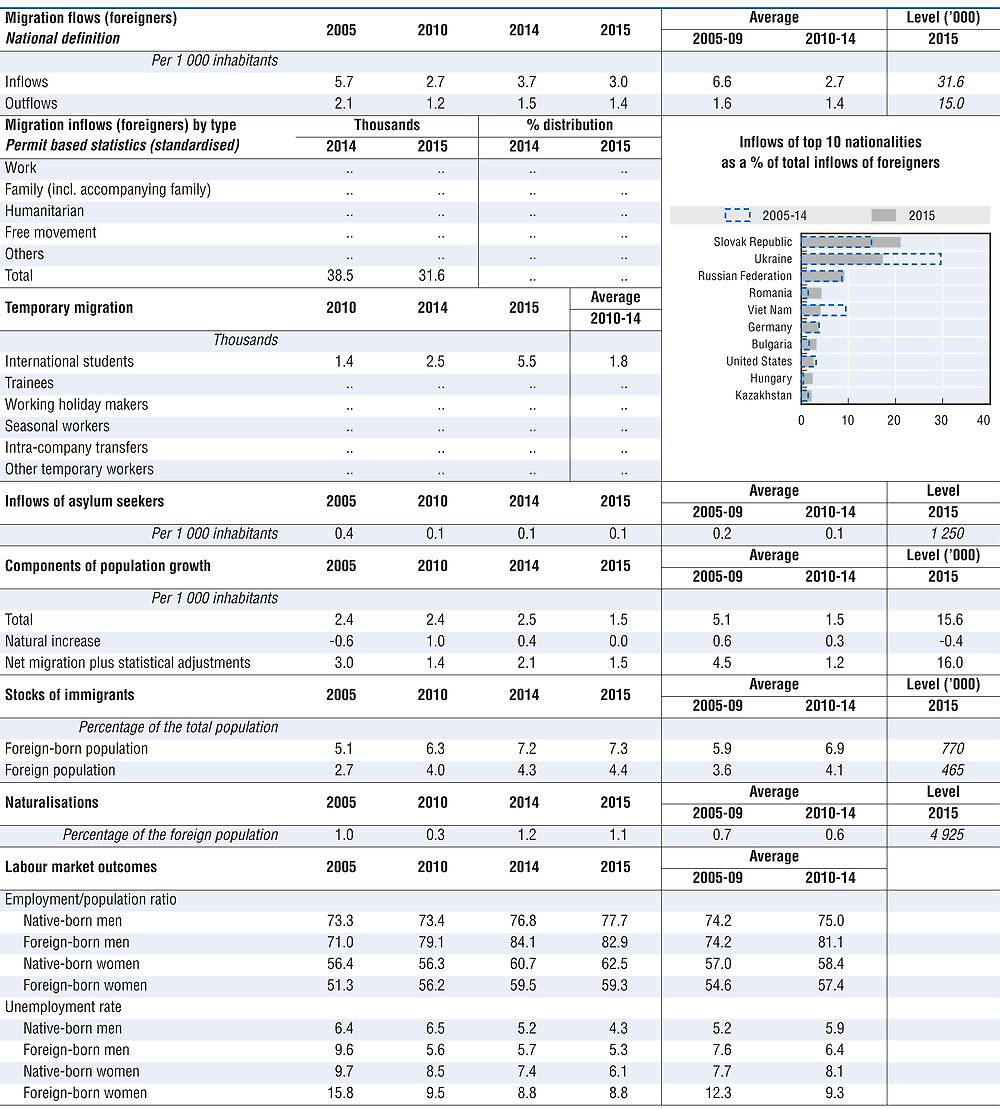Czech Republic
In 2015, around 35 000 immigrants came to the Czech Republic, down 16% from 2014, when there were about 42 000 immigrants. The number of emigrants was around 19 000 (including Czech nationals). Thus, the Czech Republic experienced positive net migration in 2015 of 16 000, 27% lower compared to 2014, when net migration was 22 000. By the end of 2015, a total of 465 000 foreigners were legally residing in the country, around 20% of them Ukrainian nationals. While the stock of migrants with temporary visas had been declining since 2012, 2015 saw a slight increase of 3% to a total of 205 000 temporary migrants resident in the country by the end of 2015.
As in previous years, newly arrived migrants in 2015 mostly came from eastern Europe, the largest source countries being the Slovak Republic (6 700), Ukraine (5 500) and Russia (2 800). Around 55% of all immigrants in 2015 were male.
Some 14 000 applications for long-term visas (i.e. visas over 90 days) were submitted in 2015, a 6% increase compared to 2014. Almost 25% were submitted by US nationals, followed by Russians and Ukrainians. Almost 70% of applications were submitted for the purpose of study or other educational activities, followed by family reunification (17%). In the past decade or so, the Czech Republic experienced a sharp increase in the numbers of foreign students, from 13 100 in 2003 to 42 200 in 2015. The trend continued in 2015. Around 65% of foreign students enrolled in Czech universities were EU nationals. As in previous years, Slovak nationals constituted the largest group (22 200 in 2015).
2015 saw a strong increase in applications for long-term residence permits: 8 200 applications were submitted, a 55% increase compared to the previous year. More than half of these were applications for the Employee Card, a single document created for third-country nationals in 2014 that replaced employment visas for stays exceeding three months. In 2015, 407 000 foreign nationals were employed (including self-employed migrants), making up 8% of the labour force.
Emigration of Czech nationals increased in 2015. Whereas in 2014 the largest group leaving the country were Ukrainians, in 2015 Czech emigrants constituted the largest group (3 900), compared to 3 200 Ukrainians, followed by 2 100 Russians.
In 2015, the Czech Republic experienced a slight increase in applications for asylum (1 500 compared to 1 200 in 2014). In 70 cases asylum was granted. Another 400 persons received subsidiary protection. As in 2014, Ukraine was the main country of origin among asylum seekers (700 applicants), followed by Syria (130) and Cuba (130). Applications from Cuban nationals have markedly increased compared to 2014 (40 applications). In 2015 68% of applicants were male and around 18% were minors. 150 children, mostly between the ages of 16 to 18, were identified as unaccompanied minors (in 2014: 23). However, only 10 lodged an application for asylum in 2015.
During 2015, the Act on the Residence of Foreign Nationals was amended and entered into force in December 2015. It extended the validity of long-term visas to up to one year and increased the time limit to apply for long-term residency. In addition, it specified who qualifies as family members of EU citizens and defined new requirements for taking the Czech language exam. In addition, a number of changes to asylum legislation entered into force in January 2016, focusing on integration measures in the area of housing, employment and language learning. Furthermore, a list of countries was introduced that the Czech Republic considers safe countries of origin.
In 2015, the Ministry of Interior also launched a special website on migration as well as a new info portal for immigrants. In addition, a “Media Working Group on Migration” was set up to improve communication with the public on migration and integration related issues.
In November 2015, a new labour migration pilot project for Ukrainian high-skilled workers, the so-called “Special Procedures for Highly Qualified Workers from Ukraine”, was launched, giving participants priority access at embassies when applying for the Employee Card. The pilot is currently capped at 500 migrants per year. In May 2016, the project was amended to change employer eligibility. Employers recruiting under the programme must pay the average prevailing wage in the occupation and region of employment, rather than 1.5 times the national average wage. The minimum firm size for participation in the pilot was lowered to three employees. In August 2016, a similar project, “Special treatment for qualified workers from Ukraine”, was launched, with a capacity of 3 800 specialised workers per year. Due to high interest the capacity was increased in February 2017. Furthermore, following the transposition of the EU Directive (2014/66/EU), a new card of intra-corporate transferees was introduced that combines work and residence permits in a single document.

